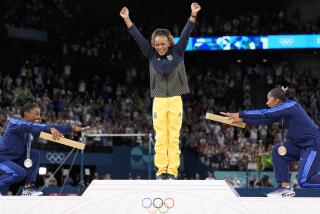THE OLYMPICS: WINTER GAMES AT ALBERTVILLE : As Usual, the Europeans Are in Full Stride : Nordic events: The U.S. is playing catch-up in cross-country skiing, ski jumping and biathlon.
- Share via
LA LECHERE, France — Figure skating and Alpine skiing--and hockey at 20-year intervals--are the glamour events of the Winter Olympics, as Americans know them.
So what does that make the Nordic events--ski jumping and cross-country skiing?
Well, on this side of the Atlantic, Nordic skiing stands every bit as tall as those other events. And so does the biathlon, which, although technically not a Nordic event, is close enough to be at least a cousin.
So it should come as no great surprise that Europeans dominate Nordic skiing and the biathlon, and that U.S. athletes are trying, still, to catch up.
Americans have won two medals in Nordic skiing, a silver by cross-country skier Bill Koch in one of the great Winter Olympic upsets in 1976, and a bronze by jumper Anders Haugen in the first Winter Games, at Chamonix, France, in 1924.
No American has won a biathlon medal.
So, if the situation sounds less than encouraging for the United States, that’s a fairly normal state of affairs. But, really, with more athletes discovering that Nordic skiing has some appeal, things are looking up, perhaps for these Games, more likely for those at Lillehammer, Norway, two years hence.
The brightest young hope is Ryan Heckman of Winter Park, Colo. Known as the Speck, he’s only 17 and he’s only 5 feet 7 and 122 pounds, but he’s also the 1991 national large-hill jumping champion. But Heckman’s favorite discipline is Nordic combined, which, as the name suggests, combines jumping and cross-country skiing as an event separate from the other jumping and the other cross-country events.
Right now, though, Heckman’s biggest asset is his potential--he needs to improve his cross-country skiing--and the traditional Nordic combined powers still reign, with Klaus Sulzenbacher of Austria the individual favorite and the Norwegians the team favorites.
The U.S. jumping team is led by Jim Holland, at 24 the youngest of the jumping Hollands of Norwich, Vt. He is hoping to crack the top 10, but none of the U.S. jumpers are expected to be serious medal contenders here, off either the normal hill or the large hill.
The power in jumping still resides in Finland, but the name has changed. Matti Nykanen, who swept the competition at Calgary in 1988, has fallen on hard times and failed to make the Finnish team, but Toni Nieminen, a 16-year-old, has leaped into the breech. Using the new V-style--ski tails together and tips spread wide--he has dominated World Cup events this season and ranks as the boy to beat.
Speaking of name changes, what with jumpers sailing farther than ever, the old numerical designations of the jumping hills have been scrapped. What used to be the 70-meter hill--jumpers were expected to go about 70 meters--now is known as the 90-meter hill, and what used to be the 90-meter is now the 120-meter. But to avoid confusion, at least in the English-speaking countries, the old 70-meter is now called the normal hill and the old 90-meter the large hill.
If there is one area in which things are looking up for the United States, it’s in cross-country skiing. A brand-new American, John Aalberg, was the class of the U.S. Olympic trials. Born in Norway, he got his citizenship last month.
And Koch, the surprise silver-medal winner of ‘76, is back in competition after nearly a six-year hiatus.
The downside is that neither is young. Aalberg is 31 and Koch 36. Koch is ahead of his own schedule, since he was aiming at the ’94 Games, and he is an experienced Olympian. At the Olympics, experience can be an equalizer.
On the women’s team, Nancy Fiddler, who will turn 36 on the day of the last women’s race here, would like to make her international mark before leaving the sport behind her. She has won 13 national titles.
In cross-country skiing, there are single-day events, two-day combined pursuit races and relays for both men and women. Scandinavian skiers and Russian Vladimir Smirnov are expected to dominate in the men’s events. Elena Vialbe of Russia and Stefania Belmondo of Italy are the favorites in the women’s events.
Biathlon, described by many as the world’s most demanding sport, is a combination of cross-country skiing and target shooting. Speed skiing requires intense physical effort, then the rifle shooting demands instant, rock-steady calm.
The United States thought it had a shot at a medal in ’88 with Josh Thompson of Gunnison, Colo., but he didn’t shoot as well as he skied and finished well out of the running. Thompson is back this year and has help from Duncan Douglas of Lake Placid, N.Y., a multisport athlete who has made significant progress in biathlon.
This year, for the first time, female biathletes are in the Olympics. Anna Sonnerup of Hanover, N.H., and Patrice Anderson of Nordic Valley, Utah, are the leading Americans, but neither is expected to challenge the favorites, Svetlana Davidova of Russia and Grete Nykkelmo of Norway.
Favorites among the men are Sergei Tchepikov of Russia and Mark Kirchner of Germany.
More to Read
Go beyond the scoreboard
Get the latest on L.A.'s teams in the daily Sports Report newsletter.
You may occasionally receive promotional content from the Los Angeles Times.






